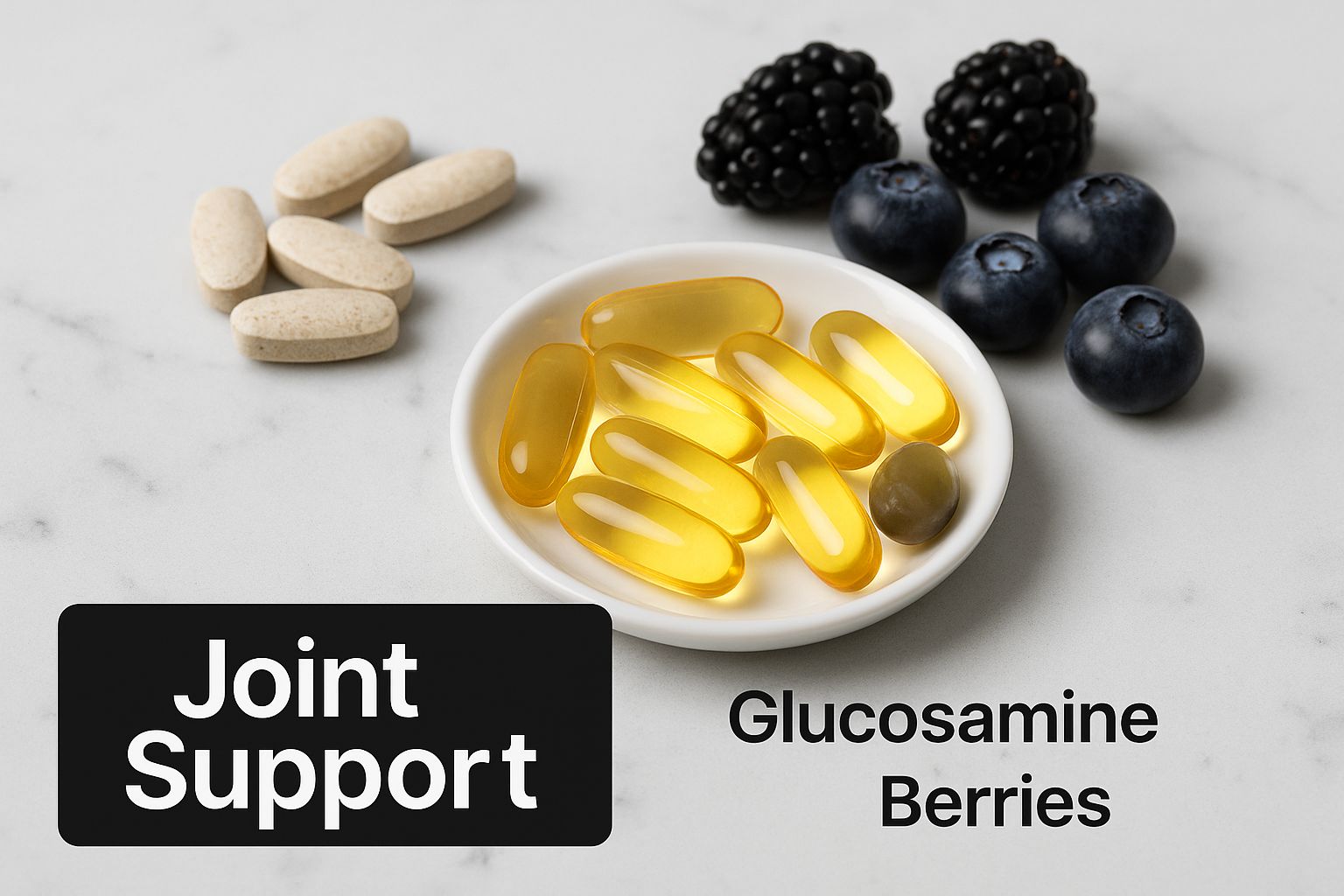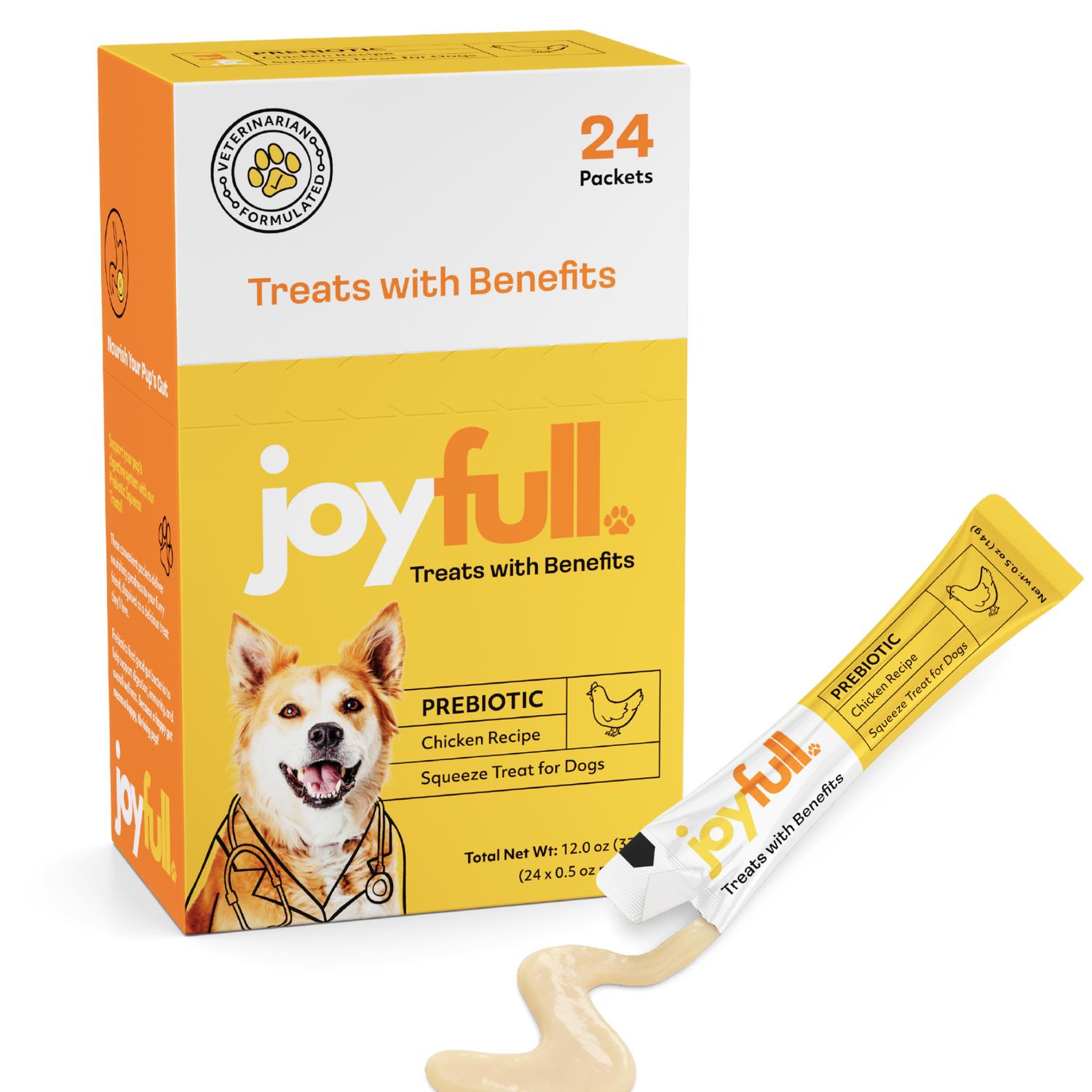
Dog Treats for Arthritis an Owner's Guide
When we talk about dog treats for arthritis, we're not just talking about a tasty snack. These are functional treats, packed with specific ingredients like glucosamine, chondroitin, and omega-3 fatty acids, all aimed at supporting your dog's joint health and keeping them mobile. Think of them less as a simple reward and more as an easy, everyday way to give your dog the key nutrients that can help ease their joint discomfort.
Understanding Canine Arthritis and How Treats Can Help

It’s tough watching a once-bouncy friend start to slow down or struggle with stiff, achy joints. As a dog owner, it's a sight that can truly break your heart. But getting to the root of the problem is the first step in making a real difference. This isn't some rare ailment, either. Canine arthritis is incredibly common, affecting dogs of all shapes and sizes, although we see it most often in senior dogs and larger breeds.
A great way to picture your dog's joints is to think of the hinges on a well-loved garden gate. For years, that gate swings open and shut without a problem, supporting every run, jump, and playful pounce. But with time and constant use, the cartilage—the natural cushion in those joints—begins to wear thin. This leads to bone-on-bone friction, inflammation, and pain. That gradual breakdown is exactly what's happening with arthritis.
Early Signs of Joint Discomfort
The first clues that your dog is experiencing joint pain can be easy to miss. Many people mistake them for the normal signs of a dog just getting older. But if you know what to look for, you can step in early and provide some much-needed relief.
Keep an eye out for these subtle changes:
- Hesitation: Does your dog pause before jumping into the car or onto their favorite spot on the couch?
- Slower Pace: Are they starting to fall behind on your daily walks or taking a little longer to get up from a nap?
- Stiffness: You might notice they seem particularly stiff and slow, especially first thing in the morning or when the weather is cold.
- Limping: A faint limp that seems to come and go can be an early indicator.
- Behavioral Changes: Some dogs become irritable or shy away from being petted on their back or hips if those areas are sore.
Arthritis is a widespread issue, affecting an estimated 20% of adult dogs globally. This has created a huge need for effective management options. As a result, the market for these solutions, including specialized dog treats for arthritis, is both significant and expanding. You can learn more about the companion animal arthritis market trends and its projected growth.
The Role of Specialized Treats
This is where dog treats for arthritis can be a game-changer. It's important to be clear: they aren't a cure. Instead, think of them as a simple yet powerful tool in your overall management plan. These treats are designed to deliver targeted, active ingredients that directly support joint function and help dial down the discomfort.
They act like a daily "tune-up" for those hardworking joint hinges, giving the body the building blocks it needs to maintain cartilage and fight inflammation. By making these functional snacks a part of your dog's daily routine, you're doing more than just giving a treat. You're providing consistent, targeted support that can help them move more freely and truly enjoy a better quality of life.
Understanding the Ingredients That Power Joint Support
When you pick out a joint support treat for your dog, you're doing more than just giving them a tasty reward. You're delivering a targeted blend of active compounds, each with a specific role in easing the discomfort of arthritis. To make an informed choice, it helps to peek behind the curtain and see what these ingredients do and how they work in harmony.
Think of your dog’s joint cartilage like a well-built brick wall. For that wall to remain sturdy and resilient, it needs both its bricks and the mortar holding them together. This is where two of the most famous joint-supporting ingredients, glucosamine and chondroitin, step in.
- Glucosamine: This is the "brick" of joint health. It's a naturally occurring compound that supplies the essential building blocks for repairing and maintaining cartilage.
- Chondroitin Sulfate: This is the "mortar." It acts like a sponge, drawing water into the cartilage. This hydration keeps the cartilage plump and cushiony, allowing it to effectively absorb shock during movement.
The Key Players in Joint Health
Beyond those foundational components, a handful of other ingredients are critical for their anti-inflammatory and supportive properties. They form a team that tackles the pain and stiffness of arthritis from different angles. Two of the most impactful are MSM and Omega-3 fatty acids.
MSM (Methylsulfonylmethane) is a natural form of sulfur, which is a crucial mineral for building and maintaining healthy connective tissues. It’s best known for its potent anti-inflammatory effects, helping to dial down swelling and pain directly in the joints. It’s like the on-site "maintenance crew" that quiets down inflammation so the body’s repair work can begin.
Omega-3 Fatty Acids, often sourced from fish oil or green-lipped mussels, are powerhouses of anti-inflammatory action. They work on a cellular level throughout the body to block the production of inflammatory compounds, providing widespread relief that directly benefits aching joints.
The growing demand for treats with these science-backed ingredients speaks volumes about their real-world impact. Formulas that combine omega-3s, glucosamine, and chondroitin are at the forefront, helping to repair cartilage and reduce inflammation. The market is projected to hit USD 6.04 billion by 2029, driven by dedicated pet owners investing in their dogs' long-term mobility and comfort.
This visual guide shows some of the most effective ingredients you'll find in high-quality joint support formulas.

As you can see, ingredients like fish oils and specific supplements are central to modern strategies for keeping our pets’ joints healthy.
To help you keep track, here’s a quick summary of the key ingredients and what they do.
Key Joint-Supporting Ingredients and Their Functions
| Ingredient | Primary Function | How It Helps |
|---|---|---|
| Glucosamine | Cartilage Repair | Provides the fundamental building blocks for creating and maintaining healthy cartilage. |
| Chondroitin | Cartilage Hydration | Draws and retains water in the cartilage, ensuring it stays plump and shock-absorbent. |
| MSM | Anti-Inflammatory | A natural source of sulfur that helps reduce joint pain, swelling, and inflammation. |
| Omega-3s | Systemic Anti-Inflammatory | Works at a cellular level to decrease the body's production of inflammatory chemicals. |
| Turmeric (Curcumin) | Natural Pain Relief | Acts as a powerful natural anti-inflammatory to help manage pain and stiffness. |
| Green-Lipped Mussel | All-in-One Support | A natural source of glucosamine, chondroitin, and unique Omega-3s for comprehensive joint care. |
This table gives you a great at-a-glance reference for what to look for on an ingredient label.
Nature's Potent Anti-Inflammatories
On top of the "big four," many of the best dog treats for arthritis also incorporate powerful natural botanicals and superfoods known for their incredible health benefits.
- Turmeric: The magic behind turmeric is its active compound, curcumin, a well-studied anti-inflammatory. It works in a way that’s similar to some pain medications but in a natural, food-based form, making it excellent for managing daily stiffness.
- Green-Lipped Mussel (GLM): Hailing from the pristine waters of New Zealand, GLM is a true joint superfood. It delivers a natural, powerful combination of glucosamine, chondroitin, and a unique blend of Omega-3s, offering a multi-pronged approach in a single, whole-food ingredient.
Knowing what each ingredient does is the first step. The next is trusting how they're sourced and combined. When formulated correctly and in the right dosages, these compounds work together synergistically for even greater benefits. You can explore our science-backed approach to pet wellness to see how meticulous formulation turns quality ingredients into real results.
How to Choose the Right Arthritis Treats

Walking down the pet aisle or scrolling online can feel overwhelming. Brand after brand promises joint relief for your dog, but how do you know which one will actually make a difference? The secret isn’t in the flashy packaging. It’s all about learning to read the label like an expert.
Your first move should be to flip the bag over and find the Guaranteed Analysis. This isn't marketing fluff; it's a legally required section where companies must list the minimum amounts of their key ingredients, like glucosamine and chondroitin. It's the most straightforward way to see exactly what you're paying for.
Deciphering Doses and Formulations
Not all joint treats are created equal. You’ll generally find them in two strengths: maintenance doses and therapeutic doses.
Maintenance treats are perfect for younger, at-risk breeds as a preventative step or for dogs with only the slightest hint of stiffness. But if your dog is already showing clear signs of arthritis—limping, slowness, or difficulty getting up—you'll need a product with a higher, therapeutic concentration to see a real improvement.
Every dog is different, so you'll need to consider their specific situation:
- Size and Weight: It’s simple biology—a Great Dane needs a much larger dose of active ingredients than a Chihuahua. Always check the package for weight-based feeding instructions.
- Symptom Severity: A dog with advanced arthritis requires more aggressive support than one just starting to slow down.
- Allergies and Sensitivities: Carefully scan the full ingredient list. If your dog has issues with chicken, beef, or certain grains, you need to make sure they aren't hiding in the formula.
A truly high-quality treat is about more than just the active ingredients. It's also about what's not in it. You want a clean formula, free from junk fillers that can actually make inflammation worse. Options like Joyfull's Treats with Benefits are a great example of treats made with both effectiveness and purity in mind.
The Smart Shopper's Checklist
To cut through the noise, there are a few key things to look for and a few red flags to avoid. One of the best indicators of a trustworthy product is the NASC Quality Seal.
The National Animal Supplement Council (NASC) seal means the manufacturer has undergone a strict third-party audit for quality control and accurate labeling. Think of it as an expert's stamp of approval, giving you peace of mind that what's on the label is actually in the treat.
As you compare products, keep this simple checklist handy.
What to Look For:
- High concentrations of active ingredients listed in the Guaranteed Analysis.
- The NASC Quality Seal for third-party verification.
- Whole-food ingredients and natural anti-inflammatories like turmeric or green-lipped mussel.
- Clear, easy-to-follow dosage instructions based on weight.
What to Avoid:
- Vague ingredients like "meat by-products" or "animal digest."
- Artificial colors, flavors, or preservatives (like BHA and BHT).
- Inflammatory fillers such as corn, wheat, and soy.
- Excess sugars like corn syrup, which can worsen inflammation and lead to weight gain.
Using this approach, you can step past the clever marketing and confidently pick a treat that is safe, effective, and truly right for your best friend.
Adding Joint Treats to Your Dog's Diet Safely
So you've found some promising dog treats for arthritis. That's a fantastic first step! But how you actually bring them into your dog's daily routine is just as crucial as the treat itself. Diving in headfirst by tossing a full serving into their bowl can sometimes backfire and lead to an upset stomach.
The key is to go slow. Think about it this way: if you suddenly introduced a rich, new food to your own diet, you wouldn't start with a giant serving. Your dog's digestive system needs that same gentle introduction. Start by giving just a small piece of the recommended serving for a few days. Let their body get used to it.
Over the next week or so, you can gradually work your way up to the full daily amount listed on the package. This "low and slow" approach is your best bet for avoiding digestive issues like gas or diarrhea, making the whole experience a positive one for your pup right from the start.
Mind the Calories and Dosage
It's so easy to get caught up in the benefits of these treats that we forget one simple thing: they have calories. Even though they're meant to help, they still count towards your dog's daily food intake. This is a big deal for dogs with arthritis, where every extra pound puts more pressure on those already aching joints.
To keep your dog from accidentally gaining weight, you have to account for the calories in their new joint treats. The easiest way to do this is by slightly cutting back on their regular kibble or food portions to keep things balanced.
Following the dosage on the package is also non-negotiable. Those instructions are there for a reason, carefully figured out based on your dog's weight to provide the right amount of active ingredients without overdoing it.
Giving your dog more than the recommended amount won't make their joints feel better faster. In fact, it's more likely to cause an upset stomach or throw their diet out of whack. Consistency with the correct dose is what truly makes a difference.
Always Consult Your Veterinarian
Before you add any new supplement to your dog’s regimen, including dog treats for arthritis, a chat with your vet is the most important step you can take. They know your dog's full health history and can give you advice that’s specifically for them.
This conversation is absolutely critical if your dog:
- Has other health conditions: Things like kidney disease, pancreatitis, or other chronic illnesses often require very specific diets.
- Is on other medications: Your vet needs to make sure nothing in the treats will interfere with their current prescriptions, like NSAIDs or other pain relievers.
- Has known allergies: A quick check of the ingredient list with your vet can help you spot any potential allergens you might have missed.
Think of your vet as your partner in your dog's health. Working together ensures you're choosing a path that is safe, effective, and a sustainable part of your long-term plan to keep your dog comfortable and mobile.
Taking a Whole-Dog Approach to Arthritis Management
While specialized dog treats for arthritis are a powerful tool, they work best when they're part of a bigger plan. Think of it like building a house for your dog's comfort. The treats are crucial bricks, but you still need a solid foundation and sturdy support beams to make it a truly stable and comfortable home. This multi-pronged strategy, known as a multi-modal approach, is widely considered the best way to care for an arthritic dog.
By tackling arthritis from several angles at once, you can create a daily routine and environment that minimizes joint stress and maximizes their quality of life. You become their best and most effective ally in their comfort.
Look Beyond the Treat Jar
Your dog's overall health has a massive impact on how their body copes with arthritis. Two areas where you can make a huge difference are their weight and their daily activity.
-
Weight Control is Key: Every extra pound your dog carries puts significant, unnecessary strain on their sore joints. Helping them maintain a lean body weight through a well-balanced diet is one of the most effective things you can do to bring them relief. This means being mindful of portion sizes and remembering to factor in the calories from those helpful joint treats.
-
Smart, Gentle Exercise: Movement is medicine for stiff joints, helping to keep them lubricated and the supporting muscles strong. But the type of movement is what really counts. Ditch the high-impact games of fetch and opt for gentle, low-impact activities. Swimming is a fantastic choice, as it builds muscle strength with zero pressure on the joints. Even short, consistent walks on soft surfaces like grass or a dirt trail can work wonders.
Make Your Home a Joint-Friendly Haven
You can make small, simple changes around your house that will have a big impact on your dog's daily comfort. The idea is to remove the little physical hurdles that can lead to pain or a flare-up.
A few easy tweaks can make a world of difference:
- Invest in an orthopedic dog bed. The memory foam cushions their joints and provides crucial support while they sleep.
- Lay down non-slip rugs or runners on slick floors like hardwood or tile to give them secure footing and prevent painful slips.
- Use ramps to help them get into the car or up onto the couch, which eliminates the need for jarring jumps.
Your veterinarian is a central part of this comprehensive plan. They might prescribe medications like non-steroidal anti-inflammatory drugs (NSAIDs) to manage pain and inflammation or even recommend physical therapy. In this complete care model, dog treats for arthritis serve as a powerful partner, working alongside medical treatments to provide holistic support.
This growing understanding of a combined approach is changing the market. The global canine arthritis treatment market was valued at an impressive USD 2.685 billion in 2023 and is still growing, with Europe accounting for over 30% of that market. This trend shows a clear shift toward blending traditional veterinary medicine with nutritional support from supplements and functional treats. You can discover more insights about canine arthritis treatment trends and see where the industry is heading.
Common Questions About Dog Arthritis Treats
When you’re looking into a new health product for your best friend, having questions is a good thing. It means you’re a thoughtful, caring owner. Trying to figure out the world of dog treats for arthritis can definitely bring up a few uncertainties, so let's walk through some of the most common ones. My goal is to give you clear, straightforward answers so you can make the best choice with confidence.
How Long Until I See a Difference?
It’s completely understandable to want to see your pup feeling better right away. However, it's helpful to think of these treats less like a fast-acting painkiller and more like a daily vitamin that needs time to build up in their system.
The key ingredients, like glucosamine and chondroitin, don't work overnight. They need to accumulate in your dog’s joints to start repairing cartilage and reducing inflammation. Most pet parents start to see real, noticeable improvements in their dog's comfort and mobility within 4 to 8 weeks of daily use. The most important part of that sentence is daily use. Consistency is everything.
Can My Dog Take These Treats with Other Medications?
For the most part, yes. It's actually very common for dogs to take joint support treats alongside prescription medications, like NSAIDs (non-steroidal anti-inflammatory drugs), prescribed by their vet. This is often called a "multi-modal" approach, where you tackle the problem from several angles at once. Some veterinarians even find that with long-term nutritional support from treats, they can sometimes lower the dose of a dog's prescription meds.
That said, you should never introduce a new supplement into your dog's diet without a quick chat with your veterinarian first. They know your dog's specific health profile and can give you the green light, ensuring there won't be any negative interactions with their current medications.
Are There Any Potential Side Effects?
High-quality dog treats for arthritis, made with good ingredients, are very safe for the vast majority of dogs. On the rare occasion that side effects pop up, they’re usually very mild and don't last long.
The most common issue is a little bit of digestive upset—think gas or a slightly looser stool. This sometimes happens when a new food is introduced. To sidestep this, just start with half the recommended dose for the first few days. This gives your dog’s system time to adjust. If you notice any digestive trouble that hangs on, or any other concerning reaction, stop giving the treat and check in with your vet.
Is It a Good Idea to Give These Treats as a Preventative?
Absolutely. This is a fantastic way to be proactive about your dog’s long-term joint health. It’s an especially smart strategy for certain dogs:
- Breeds Prone to Joint Issues: We're talking about German Shepherds, Labradors, Golden Retrievers, and other large breeds that are genetically more likely to develop conditions like hip dysplasia.
- Highly Active Dogs: If you have a canine athlete, a working dog, or just a pup who loves to run hard, their joints are getting a lot more wear and tear over the years.
Starting them on a lower "maintenance dose" before any stiffness or pain appears can help protect healthy cartilage. It might even delay the onset of arthritis or make it less severe when it does develop down the road.
Have more questions? We've put together a ton of helpful information in our comprehensive FAQ section for pet owners.
Ready to provide your dog with scientifically-backed joint support in a treat they'll love? At Joyfull, we formulate our treats with high-quality, clean ingredients to support a happy, active life. Explore our products and see the difference.

